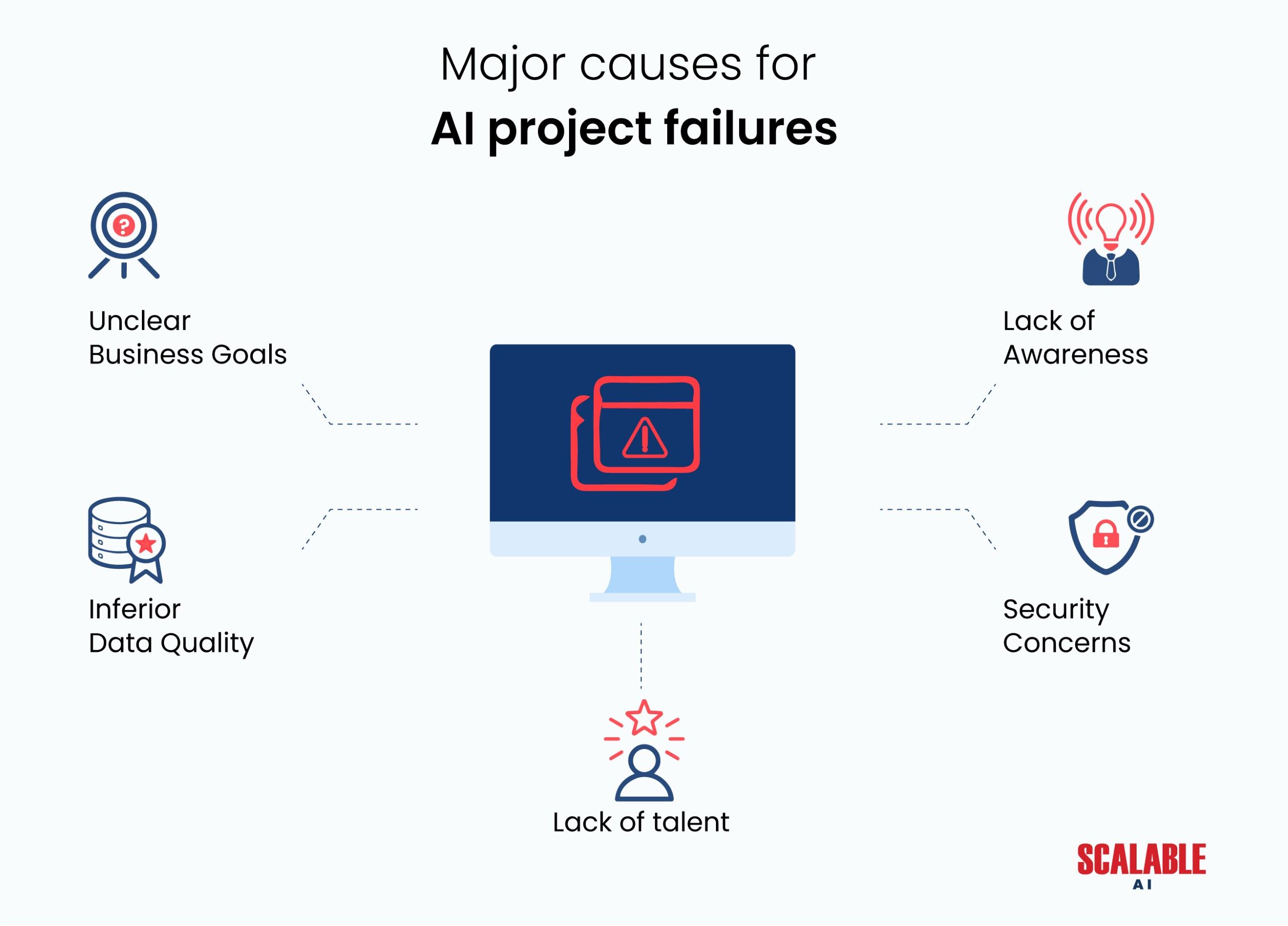Executive Summary :
Artificial intelligence (AI) isn’t a novel technology, but it is necessary to help enterprises improve efficiency, productivity, and innovation. However, many AI projects have failed to reach the desired results due to the implementation complexities. Identifying the root causes of failures is crucial for organizations aiming to tap the potential and capabilities of AI technology. The blog explores factors behind the failure of Artificial Intelligence projects and provides insights to overcome the barriers to successful adoption, implementation, and optimization of AI technologies.
Why do AI Projects fail?
One of the primary reasons why AI projects fail is the lack of a realistic and practical objective to solve the pressing business problem. On the other hand, successful projects have a well-defined and realistic target to achieve rather than aiming for ambitious goals. Despite having a clearly defined business problem and an AI solution, stakeholders tend to envision ambitious results when it comes to AI. What starts as a straightforward project often transforms into a complex attempt with grandiose objectives. Even projects with a narrow scope initially can quickly expand to tackle challenges and achieve new targets.
Top Reasons Behind AI Project Failures

Unclear business goals
Not understanding the possible use cases of AI technology is the central fault line in enterprise strategy. The key to success is understanding its purpose, not just the pressure to adopt it. Businesses in data-rich fields like healthcare, retail, and media can leverage AI’s strengths: prediction, pattern recognition, trend analysis, and natural language processing. To bridge the understanding gap, pinpoint the tasks, challenges, and opportunities where AI can most benefit. Clearly define the problem, break it into manageable pieces, and tackle each individually. Remember, AI isn’t a magic spell; it needs a proper strategic approach.
Data Quality
AI adoption often struggles with challenges related to data quality and quantity. Even if the database and IT infrastructure are robust, faulty data sets can lead to AI model malfunctions. Additionally, latency and throughput issues during data flow and processing can disrupt the production environment. Given that incorrect data aggravates problems, ensuring data quality is paramount.
Specialized Talent
Most enterprises have a good idea of how to execute an AI project, but failure could occur due to a lack of specialized talent. According to various surveys, the top challenge for businesses adopting AI is the lack of skilled data science professionals. Due to AI skill shortages, creating a talented team can be costly and time-consuming. Companies couldn’t accomplish much without a team with proper training and business domain expertise, leading to project failure. A dedicated team develops and deploys the model while simultaneously managing the integration. Organizations need the right team to run the AI project and deliver the right solution. It is about organizing the best team to provide the optimum results, comprising domain experts, product managers, data scientists, and engineers.
Security Concerns
Implementing and scaling AI projects needs a security-first approach. As the AI project expands, the vulnerabilities and security risks heighten. Stakeholders must identify weaknesses and address the identified risk factors. For example, integrating AI technologies like GPT can lead to breach or exposure of company data. Another risk factor with the Large Language Models (LLMs) is the prompt injection, which can cause the manipulation of AI outputs.
Lack of awareness
Technical architecture, talent, and business objectives are essential, but the AI project’s success depends on people’s readiness. A common oversight or mistake is not adequately preparing or training the resources for the changes. There have been instances reported where companies have deployed AI in their day-to-day operations, but the workforce has rejected it. This indicates that employees don’t trust AI adoption or implementation. Organizations that fail to convey the AI impact and usefulness would see a higher chance of AI project failure.
Conclusion
Before moving to the AI adoption phase, it’s imperative to identify possible use cases for the technology. Assessing and analyzing the existing datasets becomes necessary to determine the suitability of AI in the overall scheme. Integrating AI with the existing business set-up and infrastructure requires a well-defined strategy and a rigorous testing environment. The dedicated team must be aware of the possible flaws and anticipate risks before moving to the implementation part. Successful management requires continual improvement and monitoring to ensure that the final product is aligned with evolving business and technological demands. This involves a cyclical and iterative process of collecting more data, improving algorithms, and promoting efficiency. Identifying common errors and mistakes can help enterprises develop and deliver successful AI projects.
Read Whitepaper AI Project Success: Demystifying the Path to Breakthroughs
